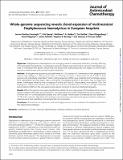Files in this item
Whole-genome sequencing reveals clonal expansion of multiresistant Staphylococcus haemolyticus in European hospitals
Item metadata
| dc.contributor.author | Cavanagh, Jorunn Pauline | |
| dc.contributor.author | Hjerde, Erik | |
| dc.contributor.author | Holden, Matthew T G | |
| dc.contributor.author | Kahlke, Tim | |
| dc.contributor.author | Klingenberg, Claus | |
| dc.contributor.author | Flægstad, Trond | |
| dc.contributor.author | Parkhill, Julian | |
| dc.contributor.author | Bentley, Stephen D | |
| dc.contributor.author | Sollid, Johanna U Ericson | |
| dc.date.accessioned | 2015-05-25T13:40:01Z | |
| dc.date.available | 2015-05-25T13:40:01Z | |
| dc.date.issued | 2014-11-11 | |
| dc.identifier | 138013240 | |
| dc.identifier | bf8f05d0-fb94-43ff-b099-812031b75274 | |
| dc.identifier | 25038069 | |
| dc.identifier | 84928194489 | |
| dc.identifier.citation | Cavanagh , J P , Hjerde , E , Holden , M T G , Kahlke , T , Klingenberg , C , Flægstad , T , Parkhill , J , Bentley , S D & Sollid , J U E 2014 , ' Whole-genome sequencing reveals clonal expansion of multiresistant Staphylococcus haemolyticus in European hospitals ' , Journal of Antimicrobial Chemotherapy , vol. 69 , no. 11 , pp. 2920-2927 . https://doi.org/10.1093/jac/dku271 | en |
| dc.identifier.issn | 0305-7453 | |
| dc.identifier.other | ORCID: /0000-0002-4958-2166/work/60196469 | |
| dc.identifier.uri | https://hdl.handle.net/10023/6688 | |
| dc.description.abstract | Objectives Staphylococcus haemolyticus is an emerging cause of nosocomial infections, primarily affecting immunocompromised patients. A comparative genomic analysis was performed on clinical S. haemolyticus isolates to investigate their genetic relationship and explore the coding sequences with respect to antimicrobial resistance determinants and putative hospital adaptation. Methods Whole-genome sequencing was performed on 134 isolates of S. haemolyticus from geographically diverse origins (Belgium, 2; Germany, 10; Japan, 13; Norway, 54; Spain, 2; Switzerland, 43; UK, 9; USA, 1). Each genome was individually assembled. Protein coding sequences (CDSs) were predicted and homologous genes were categorized into three types: Type I, core genes, homologues present in all strains; Type II, unique core genes, homologues shared by only a subgroup of strains; and Type III, unique genes, strain-specific CDSs. The phylogenetic relationship between the isolates was built from variable sites in the form of single nucleotide polymorphisms (SNPs) in the core genome and used to construct a maximum likelihood phylogeny. Results SNPs in the genome core regions divided the isolates into one major group of 126 isolates and one minor group of isolates with highly diverse genomes. The major group was further subdivided into seven clades (A–G), of which four (A–D) encompassed isolates only from Europe. Antimicrobial multiresistance was observed in 77.7% of the collection. High levels of homologous recombination were detected in genes involved in adherence, staphylococcal host adaptation and bacterial cell communication. Conclusions The presence of several successful and highly resistant clones underlines the adaptive potential of this opportunistic pathogen. | |
| dc.format.extent | 437727 | |
| dc.language.iso | eng | |
| dc.relation.ispartof | Journal of Antimicrobial Chemotherapy | en |
| dc.subject | Staphylococci | en |
| dc.subject | SCCmec | en |
| dc.subject | Molecular epidemiology | en |
| dc.subject | Multidrug resistance | en |
| dc.subject | Bacterial genomics | en |
| dc.subject | RA0421 Public health. Hygiene. Preventive Medicine | en |
| dc.subject | SDG 3 - Good Health and Well-being | en |
| dc.subject.lcc | RA0421 | en |
| dc.title | Whole-genome sequencing reveals clonal expansion of multiresistant Staphylococcus haemolyticus in European hospitals | en |
| dc.type | Journal article | en |
| dc.contributor.institution | University of St Andrews. School of Medicine | en |
| dc.contributor.institution | University of St Andrews. Infection Group | en |
| dc.contributor.institution | University of St Andrews. Biomedical Sciences Research Complex | en |
| dc.identifier.doi | 10.1093/jac/dku271 | |
| dc.description.status | Peer reviewed | en |
| dc.identifier.url | http://jac.oxfordjournals.org/content/69/11/2920/suppl/DC1 | en |
This item appears in the following Collection(s)
Items in the St Andrews Research Repository are protected by copyright, with all rights reserved, unless otherwise indicated.

